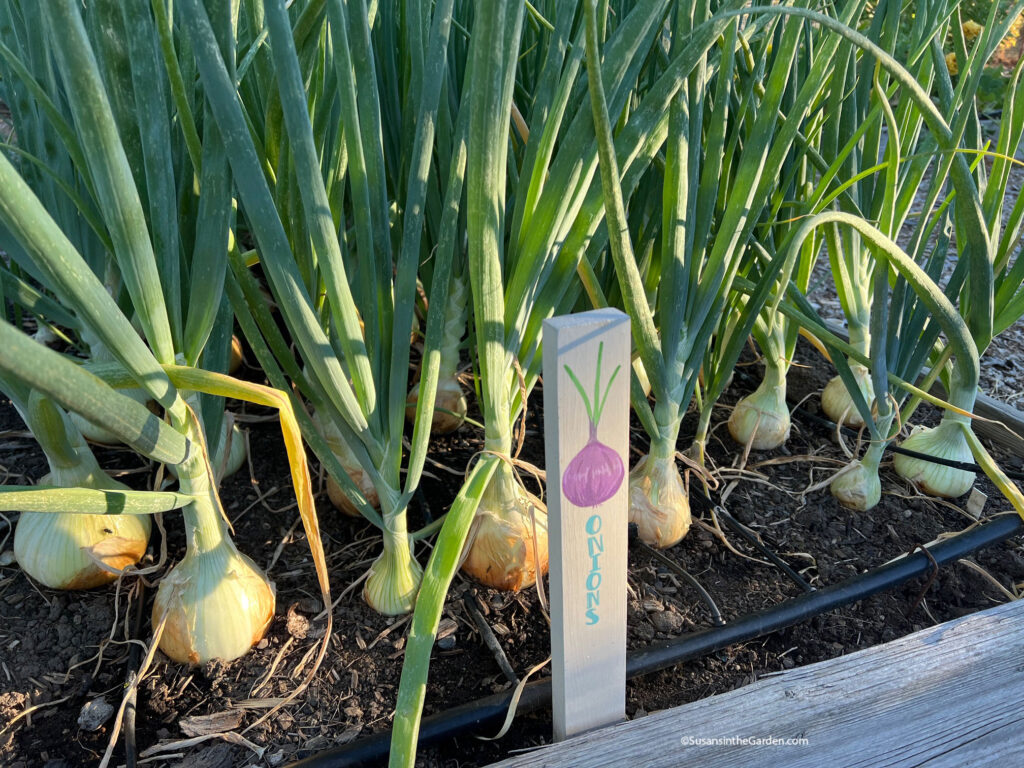How to Grow Onions and Shallots

Onions and shallots are two of the most rewarding vegetable crops you can grow. My husband, Bill, started to grow onions many years ago and instantly became hooked. A few years later, he branched out to shallots and soon excelled at that crop as well.
For today’s post, I thought you’d be interested to learn the following:
- How day-length comes into play when choosing onion varieties.
- How Bill chooses the varieties he wants to grow. That has shifted because his priorities have changed. He always enjoys perusing the seed catalogs each year to see which new varieties catch his eye.
- When and how he starts to grow onions and shallots each year.
NOTE: If you’d like to learn the specific details of growing onions, be sure to check out my How to Grow Onions post. And for details information on growing shallots, check out my How to Grow Shallots post.
In 2024, he planted ‘Ailsa Craig’ and ‘Akatama’ onions. The first variety produced amazingly large bulbs that have a wonderful, sweet taste. Unfortunately, ‘Akatama’ didn’t like our climate at all. It grew small bulbs and stopped producing quite early in the season. That’s because it isn’t well-suited to our long summer days.
How day length impacts onion varieties
Quite a few years ago, we learned that there are short day, intermediate day, and long day onion varieties. They are based upon the number of hours of daylight the various regions of the U.S. get. Here in Spokane, Wash., we are blessed with gloriously long days each summer. Because of this, we need to grow long day onion varieties.
Dixondale Farms is an onion plant supplier that specializes in varieties for all over the U.S. There’s a map on their website that indicates which region you’re in. Once you know that, go to the corresponding pages to see which varieties are well-suited for your garden.
When we noticed that ‘Akatama’ had stopped growing early, I did a bit of research. It turns out that it’s an intermediate-day onion variety. Aha! (I have to admit the information was hard to find so it was an easy mistake to make.)
How Bill chooses onion and shallot varieties
I mentioned how Bill’s priorities have changed over the years. Early on, he always grew long-day onion varieties that keep a long time in storage. ‘Patterson’ is a good example as it keeps for 8 to 10 months after harvest. That’s impressive!
We primarily grow onions for making tomato sauce and salsa in the fall. That means we don’t necessarily need long-keepers. Bill prefers a nice sweet onion for those types of projects. He particularly likes ‘Ailsa Craig’ which produces HUGE bulbs! (see photo at left) They also have a reported storage life of just 1 month. I’m happy to report that ours are still doing well a few months beyond that. We’ve been storing them in a box in our garage.
For this year’s garden, he’ll also grow ‘Barolo’, which is a red, long-day onion variety. Baker Creek Heirloom Seeds and Johnny’s Selected Seeds carry them.
Bill also likes growing shallots for special culinary projects. He’s been growing ‘Zebrune’ for the past few years. For 2025, he’s going to try ‘Creme Brulee’ shallots from Johnny’s Selected Seeds.
(note: You can always see the crops and varieties we’re growing by going to the Susan’s Garden – 2025 page on my website.
When to grow onions and shallots from seed
Bill usually starts onion seeds indoors in early January. But he says any time after the first of the year into early February is fine. “I find this is just one of those fun projects to break up the winter doldrums,” he says. “That’s because once the seeds are planted, the garden season has officially begun.”
As you can see in the photo, he does a mass-planting of seeds in a container. Then puts it under a grow light. He occasionally gives the seedlings a small amount of fish fertilizer. And they also get a “haircut” whenever the seedlings get long and lanky.
In early April when the soil is dry enough, he separates out the seedlings and trims the roots a bit. Then he plants them a few inches apart. Bill also covers the planting with floating row cover for a few weeks to give some weather and bird protection. He monitors the crop and thins the plants when we need green onions in the kitchen!



